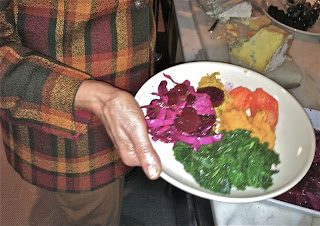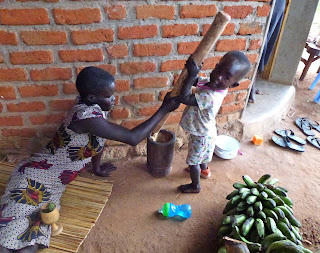poetrysciencetalks:a monthly salon where I serve a meal before an evening's talk and try to make the menu reflect the presentation.
Chapter One: planning the meal.
December’s pst was about the Singularity, an idea that a time is coming when machines will become both self-conscious, and more intelligent than humans. To some, this seems great, a kind of techno-rapture. I fall in another camp, but still, it was great creating a menu to match this talk presented by an Associate Professor in Applied Computer Network Administration who has a strong interest in ecstatic practices and mystical eschatology!
First food thoughts jumped to a cartoonish Rosie the robot/George Jetson technology. I had fleeting visions of robotic pacojets and centrifuges’ or “Soylant Green” nutrient pills, but thoughts about using fancy machines to make fancy futuristic foods dissipated like so much liquid nitrogen. After all, cooking is technology, and some theorize our use of this technology early-on is what distinguished humans from the rest of the animal kingdom. The marriage of food and fire is our very essence, so using technology to cook, no matter how futuristic the machines, seems actually, antiquated.
Second thoughts were helped along by madcap email discussions with my son, the neuroscientist, and my niece who is writing her dissertation about something I don’t quite grasp but it has to do with technology and sustainability. We discussed computers as tools that handle complexity. Computers figure-out complex things we mostly can’t, even if our human minds created the programs to set the figuring in motion. I started thinking about “complex” flavors. Pesto, say, is not complex, even though it's a blend of flavors. Your mouth can pull apart how the elements complement each other. Curries on the other hand, are complex. We can distinguish characteristics (i.e. hot or sweet) but most of us can’t tell exactly what’s in the blend.
Computers expand (according to my niece) but also limit (according to my son) how we think because the algorithms organize our access to information. This brought to mind hyperlinks, and how they lead you on a journey, and how flavors too, migrate and change. Tasting flavors also leads you on a journey.
The menu I settled upon offered platters of “base” foods, which I shaped into 1’s and 0’s to represent computer code. Some of the shapes were formed with cookie cutters (technology) and some occurred naturally.
 |
| Delicata squash 0’s and tofu 1’s to represent computer code. The base foods were plain, flavored only with salt and pepper. There was also a big bowl of Basmati rice. |
I began searching for recipes online, but push comes to shove, books offered better and more in-depth information. Julie Sahni, Madhur Jaffery, Naomi Duguid and Jeffrey Alford, Nancie McDermott, Elisabeth Lambert Ortiz, all champions!
I did find a Japanese curry recipe here:
http://www.seriouseats.com/recipes/2010/06/how-to-make-japanese-curry-rice-from-scratch-recipe.html though I doctored the recipe as I was interested in making sauce for the 1’s and 0’s, not stew.
An interlude:
(It was lovely, so lovely eating a meal of sauce.)
Luscious, spicy Thai Green curry with coconut milk, fresh herbs,
and diced eggplant.
Malaysian pineapple curry thickened and sweetened with fresh pineapple puree.
Pungent North Indian buttermilk curry, with curry leaves and black mustard seeds.
The curry from Martinique used ground yellow mustard
and had diced ripe mango and sweet potato.
Japanese curry used Worcestershire, potatoes, carrots, peas and S&B.
Warm and rich, Japanese curry is a mash-up of cultures; Indian spices thickened by European roux.
chapter two: (and then there was dessert.)
Cookies: text files stored on your hard-drive, and also sweet treats.
I thought sandwich cookies might represent our relationship with technology,
but perusing the web I came upon this recipe for Fig Newtons:
Fig Newton architecture seemed more apt; rich dough enclosing a fruitful center. Also, and this may seem off topic but bear with me, Fig Newtons were my sister’s favorite cookie. It was my sister who introduced me to poetryscience and every month when I cook for the salon I think about her. She passed away from colon cancer three years ago. When I rolled the dough for the cookies I was filled with longing for her.
Another aspect of the Singularity is that when it comes, humans may be able to merge consciousness with the machine’s “super-consciousness,” freeing us from the frailties of our bodies while preserving our minds. This is not wholly far-fetched, just the other day the New York Times had an article on bioengineering that spoke about the possibility in the not too distant future of storing digital information insides human cells. http://www.nytimes.com/2011/12/06/science/drew-endy-better-computing-for-the-things-we-care-about-most.html
Maybe such a process could be reversed: instead of our becoming
cyborgs, machines could become humanized?
During the presentation the speaker asked us to think about how we’d like this merging of mind and machine? The thought horrifies me, but got me thinking about my sister again. She loved science fiction, and the idea of a Cyborgian Society. As she was dying, she found tremendous comfort thinking her consciousness would merge into some kind of universal energy force. I wondered how I’d feel having access to her now, via computer, and then it hit me like a flash! I do have my sister, now and forever, in the taste of a cookie.



















